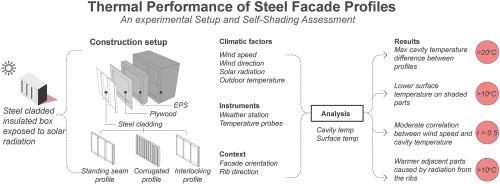钢立面轮廓的热性能:实验设置和自遮阳评估
IF 7.4
2区 工程技术
Q1 CONSTRUCTION & BUILDING TECHNOLOGY
引用次数: 0
摘要
建筑的冷暖能源需求受到围护结构设计和施工的影响。本研究探讨了普通钢板型材的外形、方向、取向和自遮阳潜能如何影响围护结构的热工性能、空气流动和热增益。在阿德莱德地中海气候的太阳辐射下测试了三种钢包层轮廓。在不同方位和剖面方向上,每隔15分钟记录一次地表、空腔空气和内部空间温度,同时固定气象站监测空气温度、湿度、风速和太阳辐射。三种钢板型材为立缝、波纹、联锁。立缝剖面始终表现出最高的空腔温度,其值比其他剖面高出高达20°C,表明在这种设置下的热性能相对较差。波纹型材表现最好,特别是当取向水平,减少热量增益。研究还表明,通过腔内自然对流的气流有显著的影响。在密闭性较好的条件下,缺乏肋突遮阳的联锁型材与其他两种型材相比,具有更高的腔温,差异超过14°C。这项研究为钢包层轮廓和自遮阳在减少冷却能源需求方面的作用提供了有价值的见解。它是进一步探索钢板性能、肋深和轮廓设计的基础,支持节能建筑实践的发展。本文章由计算机程序翻译,如有差异,请以英文原文为准。

Thermal performance of steel facade profiles: An experimental setup and self-shading assessment
The energy demand for heating and cooling in buildings is impacted by envelope design and construction. This study investigates how the profile shape, direction, orientation, and self-shading potential of common steel sheet profiles affect thermal performance, air flow and heat gain of the envelope. Three steel cladding profiles were tested under solar radiation in Adelaide's Mediterranean climate. Surface, cavity air, and internal space temperatures were recorded at 15-min intervals for different orientations and profile directions, while a fixed weather station monitored air temperature, humidity, wind speed, and solar radiation. The three steel sheet profiles are standing seam, corrugated, and interlocking. The Standing seam profile consistently exhibited the highest cavity temperature, with values exceeding that of the other profiles by up to 20 °C, indicating relatively poorer thermal performance under this setup. The Corrugated profile performed the best, particularly when oriented horizontally, reducing heat gain. The study also showed that airflow through natural convection within the cavity had a significant impact. Under more airtight conditions, the Interlocking profile, which lacked shading provided by the rib protrusion, exhibited higher cavity temperatures, with differences exceeding 14 °C compared to the other two profiles. This research provides valuable insights into the role of steel cladding profiles and self-shading in reducing cooling energy demand. It serves as a foundation for further exploration of steel sheet properties, rib depth, and profile design, supporting the development of energy-efficient building practices.
求助全文
通过发布文献求助,成功后即可免费获取论文全文。
去求助
来源期刊

Journal of building engineering
Engineering-Civil and Structural Engineering
CiteScore
10.00
自引率
12.50%
发文量
1901
审稿时长
35 days
期刊介绍:
The Journal of Building Engineering is an interdisciplinary journal that covers all aspects of science and technology concerned with the whole life cycle of the built environment; from the design phase through to construction, operation, performance, maintenance and its deterioration.
 求助内容:
求助内容: 应助结果提醒方式:
应助结果提醒方式:


